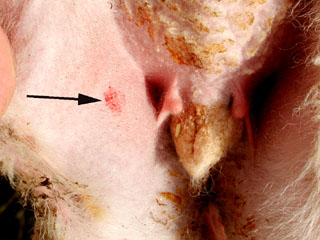
| The black arrow identifies the typical scab that begins forming 2-3 days after vaccination on the inside of the thigh. |
Introduction/Causative Agent:
Contagious ecthyma (CE), also known as soremouth (sore mouth) or orf, is an acute infectious disease of sheep and goats. Contagious ecthyma is caused by a virus that is a member of the poxvirus group. The disease is widespread in the sheep population and affects all breeds. Young animals are generally more susceptible than adults.Clinical Signs/Disease Transmission:
This disease is characterized by the formation of vesicles, pustules, and thick scabs on the lips, nostrils, face, eyelids, teats, udder, feet, and occasionally, inside the mouth. These usually appear about 3-14 days after exposure to the virus, and the scabs last 1-6 weeks. CE causes reduced gain and feed efficiency in feeder lambs. It is most serious when nursing animals contract the disease. Affected lambs/kids refuse to nurse and may die from starvation. The infection may be transmitted to the teats and udder of the mother, causing pain and abandonment of the lamb or kid. Mastitis may also result. The disease usually clears up on its own unless the animal is severely affected. This virus can survive for very long periods in scabs from infected animals that drop into the bedding and environment. This may serve as a source of infection for other animals many months later. The disease is commonly introduced into a flock/herd by replacement or breeding animals and by contact with bedding material, trucks, and vehicles contaminated by the CE virus.Diagnosis:
A diagnosis is usually made based on the appearance of the lesions. When required, samples of blood and tissue can also be sent to a laboratory for an exact (definitive) diagnosis. The disease can resemble ulcerative dermatosis, sheep pox, and Staphylococcus dermatitis, so a veterinarian should examine flocks/herds suspected of having CE.Treatment/Prevention:
Because the infection will usually clear on its own, treatment of CE focuses on helping the severely affected animals. This may mean tube feeding young animals with mouth lesions, and treating lesions that have become infected by bacteria with topical antibiotics. Because of potential scarring and spread of infection, scabs should not be removed. Carefully observe ewes/does that are nursing affected lambs/kids for evidence of teat lesions and mastitis. If these occur, remove the lamb/kid and treat the mother appropriately.Vaccination for CE is a relatively simple procedure and should be done routinely in all but completely isolated flocks/herds. In problem flocks/herds, the lambs/kids may need to be vaccinated at 6-8 weeks to help prevent the disease. In flocks/herds with severe problems, the vaccine may need to be given when the lamb/kid is just 2-3 days old. Protection from vaccination may last from 2 years to life depending on the vaccine and the animalís immune response. Most producers choose to vaccinate the entire flock/herd at one time, and then only vaccinate newborns and new additions to the herd, thereafter.
Vaccination is performed by scarifying (scratching) a small spot in an area without wool or hair and "painting" the virus on this area. Lambs/kids are usually vaccinated on the inner thigh and ewes/does on the inner surface of the ear or behind the elbow. When an outbreak occurs, immediate vaccination of the entire flock/herd is usually beneficial if no more than 10 to 20 percent of the flock/herd is affected.
 |
|
Human Health Risks: CE is transmissible to humans, causing painful sores that may last for several weeks. Thoroughly wash exposed skin areas, and then apply a skin antiseptic. Keep small children away from infected animals. The vaccine can also cause the disease in humans, so it is important to use caution when handling it. People handling infected animals or the vaccine should wear rubber or plastic gloves to prevent the virus from entering through small cuts or abrasions.